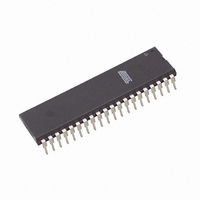ATMEGA16A-PU Atmel, ATMEGA16A-PU Datasheet - Page 280

ATMEGA16A-PU
Manufacturer Part Number
ATMEGA16A-PU
Description
MCU AVR 16K FLASH 16MHZ 40-PDIP
Manufacturer
Atmel
Series
AVR® ATmegar
Specifications of ATMEGA16A-PU
Core Processor
AVR
Core Size
8-Bit
Speed
16MHz
Connectivity
I²C, SPI, UART/USART
Peripherals
Brown-out Detect/Reset, POR, PWM, WDT
Number Of I /o
32
Program Memory Size
16KB (8K x 16)
Program Memory Type
FLASH
Eeprom Size
512 x 8
Ram Size
1K x 8
Voltage - Supply (vcc/vdd)
2.7 V ~ 5.5 V
Data Converters
A/D 8x10b
Oscillator Type
Internal
Operating Temperature
-40°C ~ 85°C
Package / Case
40-DIP (0.600", 15.24mm)
Processor Series
ATMEGA16x
Core
AVR8
Data Bus Width
8 bit
Data Ram Size
1 KB
Interface Type
2-Wire/SPI/USART
Maximum Clock Frequency
16 MHz
Number Of Programmable I/os
32
Number Of Timers
3
Maximum Operating Temperature
+ 85 C
Mounting Style
Through Hole
3rd Party Development Tools
EWAVR, EWAVR-BL
Development Tools By Supplier
ATAVRDRAGON, ATSTK500, ATSTK600, ATAVRISP2, ATAVRONEKIT
Minimum Operating Temperature
- 40 C
On-chip Adc
8-ch x 10-bit
Package
40PDIP
Device Core
AVR
Family Name
ATmega
Maximum Speed
16 MHz
Operating Supply Voltage
3.3|5 V
Controller Family/series
AVR MEGA
No. Of I/o's
32
Eeprom Memory Size
512Byte
Ram Memory Size
1KB
Cpu Speed
16MHz
Rohs Compliant
Yes
For Use With
ATSTK600 - DEV KIT FOR AVR/AVR32ATSTK500 - PROGRAMMER AVR STARTER KIT
Lead Free Status / RoHS Status
Lead free / RoHS Compliant
Available stocks
Company
Part Number
Manufacturer
Quantity
Price
Part Number:
ATMEGA16A-PU
Manufacturer:
AT
Quantity:
20 000
- Current page: 280 of 352
- Download datasheet (8Mb)
Figure 26-8. Serial Programming Instruction example
26.9
26.10 Programming via the JTAG Interface
26.10.1
280
Byte 1
SPI Serial Programming Characteristics
ATmega16A
Programming Specific JTAG Instructions
Load Program Memory Page (High/Low Byte)/
Load EEPROM Memory Page (page access)
Bit 15 B
Byte 2
Adr M M S S B
A
For characteristics of the SPI module, see
Programming through the JTAG interface requires control of the four JTAG specific pins: TCK,
TMS, TDI and TDO. Control of the reset and clock pins is not required.
To be able to use the JTAG interface, the JTAGEN Fuse must be programmed. The device is
default shipped with the fuse programmed. In addition, the JTD bit in MCUCSR must be cleared.
Alternatively, if the JTD bit is set, the External Reset can be forced low. Then, the JTD bit will be
cleared after two chip clocks, and the JTAG pins are available for programming. This provides a
means of using the JTAG pins as normal port pins in running mode while still allowing In-System
Programming via the JTAG interface. Note that this technique can not be used when using the
JTAG pins for Boundary-scan or On-chip Debug. In these cases the JTAG pins must be dedi-
cated for this purpose.
As a definition in this datasheet, the LSB is shifted in and out first of all Shift Registers.
The instruction register is 4-bit wide, supporting up to 16 instructions. The JTAG instructions
useful for Programming are listed below.
Byte 3
Adr LSB
Page Offset
0
Serial Programming Instruction
Byte 4
Program Memory/
EEPROM Memory
Page Buffer
Page N-1
Page 0
Page 1
Page 2
Byte 1
“SPI Timing Characteristics” on page
Page Number
Bit 15 B
Byte 2
Write Program Memory Page/
Write EEPROM Memory Page
Adr MSB
Byte 3
A A dr r L L SB B
298.
0
8154B–AVR–07/09
Byte 4
Related parts for ATMEGA16A-PU
Image
Part Number
Description
Manufacturer
Datasheet
Request
R

Part Number:
Description:
Manufacturer:
Atmel Corporation
Datasheet:

Part Number:
Description:
IC AVR MCU 16K 16MHZ 5V 44TQFP
Manufacturer:
Atmel
Datasheet:

Part Number:
Description:
IC AVR MCU 16K 16MHZ 5V 44-QFN
Manufacturer:
Atmel
Datasheet:

Part Number:
Description:
IC AVR MCU 16K 16MHZ 5V 40DIP
Manufacturer:
Atmel
Datasheet:

Part Number:
Description:
MCU AVR 16K FLASH 16MHZ 44-QFN
Manufacturer:
Atmel
Datasheet:

Part Number:
Description:
IC AVR MCU 16K 16MHZ COM 40-DIP
Manufacturer:
Atmel
Datasheet:

Part Number:
Description:
IC AVR MCU 16K 16MHZ COM 44-QFN
Manufacturer:
Atmel
Datasheet:

Part Number:
Description:
IC AVR MCU 16K 16MHZ IND 40-DIP
Manufacturer:
Atmel
Datasheet:

Part Number:
Description:
IC AVR MCU 16K 16MHZ IND 44-QFN
Manufacturer:
Atmel
Datasheet:

Part Number:
Description:
IC AVR MCU 16K 16MHZ IND 44-TQFP
Manufacturer:
Atmel
Datasheet:

Part Number:
Description:
IC MCU 8BIT 16KB FLASH 44TQFP
Manufacturer:
Atmel
Datasheet:

Part Number:
Description:
MCU AVR 16K FLASH 16MHZ 44-TQFP
Manufacturer:
Atmel
Datasheet:

Part Number:
Description:
IC AVR MCU 16K 16MHZ COM 44-TQFP
Manufacturer:
Atmel
Datasheet:











